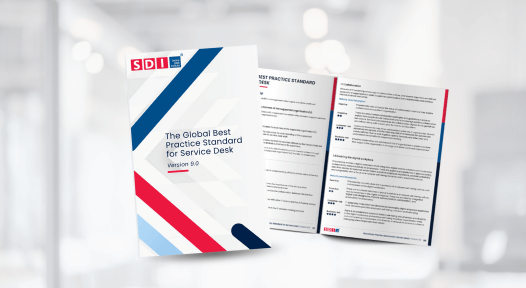Digital Experience Mapping (DEM) is the practice of walking through every IT touchpoint from the user’s perspective to uncover hidden friction, confusing journeys, and gaps between service quality and user perception. By linking technical performance with real user emotions, DEM helps IT move beyond “meeting SLAs” to delivering services that feel easier, faster, and more valuable. The result is higher self-service adoption, faster resolutions, fewer repeat tickets, happier users, and clearer business value—making DEM a powerful tool for both improving satisfaction and driving efficiency.
 Written by John Noctor, Chief Customer Success Officer, SDI.
Written by John Noctor, Chief Customer Success Officer, SDI.
Digital Experience Mapping
We’ve all been there. You think you’ve nailed your IT services, the portal’s up, the chatbot’s live, self-service is ticking along nicely, and yet you still get grumbles, escalations and that one user who swears, “nothing ever works properly around here.”
The problem? We think we know what the digital experience is like, but unless we actually map it, we’re flying blind.
So, what is Digital Experience Mapping (DEM)?
In simple terms, DEM is a structured way of looking at every single digital touchpoint your users have with IT. From logging a ticket to getting an update, resetting a password, or reading a knowledge article, DEM puts it all on the table.
It’s part service design, part detective work, and part empathy exercise. And it’s not about the “internal view” it’s about walking through those steps as the user experiences them.
Why is it so important?
Because perception is reality. In ITSM, you can hit your SLAs all day long, but if the journey is clunky, slow, or confusing, your users will still have a poor experience. DEM helps you:
🔹 Spot friction points you didn’t even know existed (like that knowledge article with great content but a confusing title that no one ever finds).
🔹 Understand why certain channels aren’t being used.
🔹 Link technical performance with emotional impact, yes, feelings matter in ITSM.
Done well, DEM changes the conversation from “We’ve met the SLA” to “We’ve made this easier, faster and better for the people who use it.”
What outcomes can DEM drive?
Here’s where DEM work can lead to:
🔹 Higher self-service adoption (because it’s actually usable and enjoyable).
🔹 Faster resolution times by removing hidden delays in the journey.
🔹 Happier users, measurable through NPS, satisfaction surveys, or sentiment tracking.
🔹 Reduced repeat tickets by fixing root causes.
🔹 A clearer link between IT and business value, something every CIO loves to see.
Who should be involved?
This is not an “IT-only” exercise. To get it right, you need:
🔹 Service Desk Analysts – they know the real pain points.
🔹 ITSM Tool Admins – for usage and performance data.
🔹 Business Relationship Managers – to link changes to business outcomes.
🔹 Experience Managers / CX pros – to bring customer-focused thinking.
🔹 Actual end users – include them in workshops. They’ll tell you what’s really happening.
Value to the organisation
When you fix the digital experience, you’re not just making life easier for users. You’re freeing up IT time, reducing escalations, increasing adoption of your investments (like that shiny new self-service portal), and improving your reputation across the business. It’s one of those rare initiatives where user satisfaction and operational efficiency both go up.
Practical steps to get started:
-
Pick a service – Don’t try to map everything at once. Start with one high-impact journey like incident resolution.
-
Define your personas – Who are you mapping for? A field engineer’s needs will differ from a call centre agent’s.
-
List all touchpoints – Every click, every notification, every handoff.
-
Gather the data – Mix hard stats (usage, MTTR) with human feedback (surveys, interviews).
-
Map the journey -Visualise it, including both process steps and user emotions.
-
Identify pain points – Where’s the friction? Where’s the frustration?
-
Prioritise fixes -You can’t do it all at once. Go for high-impact, low-effort wins first.
-
Act and review – Implement changes, measure the impact, and keep iterating.
My tips?
🔹 Don’t let DEM become a “one-and-done” project. The tech changes, the people change, the business changes, so the experience will change too.
🔹 Build DEM into your continual improvement cycle and review it at least annually, or after major service changes.
Final thought
Digital Experience Mapping is not about making pretty diagrams to show in a meeting. It’s about seeing what your users see, feeling what they feel, and fixing what needs fixing. When you get it right, it’s one of the most powerful tools you have to close the gap between IT’s perception of service quality and the reality on the ground.
And trust me, once you’ve done it once, you’ll start seeing those “invisible” experience gaps everywhere… and you won’t be able to leave them alone.
 If you’re interested in exploring Digital Experience Mapping in more depth, the next step is to look at how it fits within a broader framework of IT service excellence.
If you’re interested in exploring Digital Experience Mapping in more depth, the next step is to look at how it fits within a broader framework of IT service excellence.
SDI’s Global Best Practice Standard for Service Desk provides exactly that—a proven model covering experience, leadership, culture, processes, and continual improvement. By downloading the Standard, you’ll see how DEM connects with the wider practices that drive world-class service, giving you a clear roadmap to benchmark, improve, and sustain outstanding digital experiences.



















